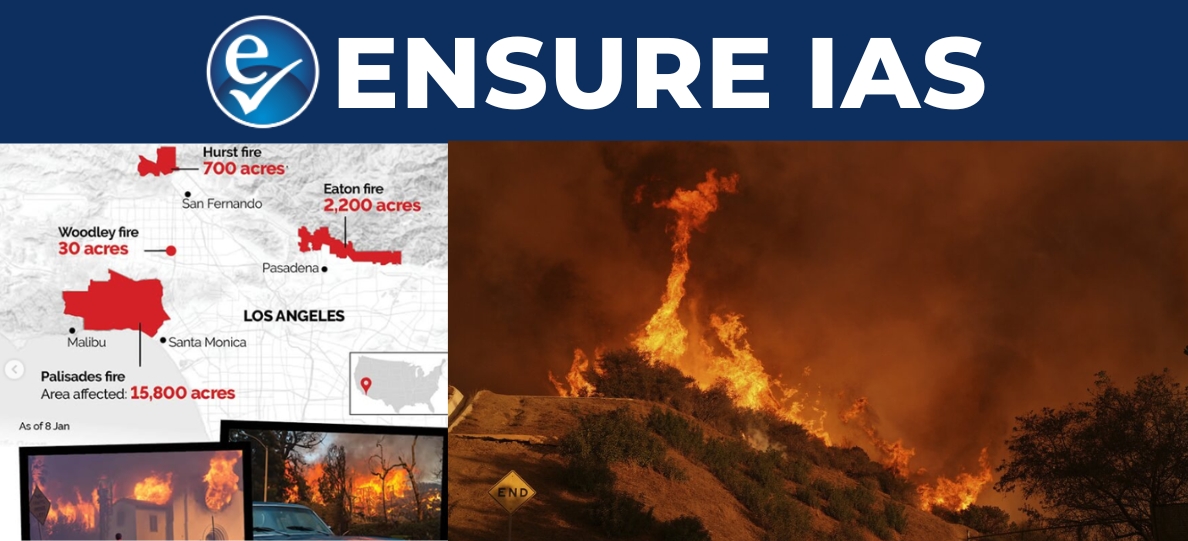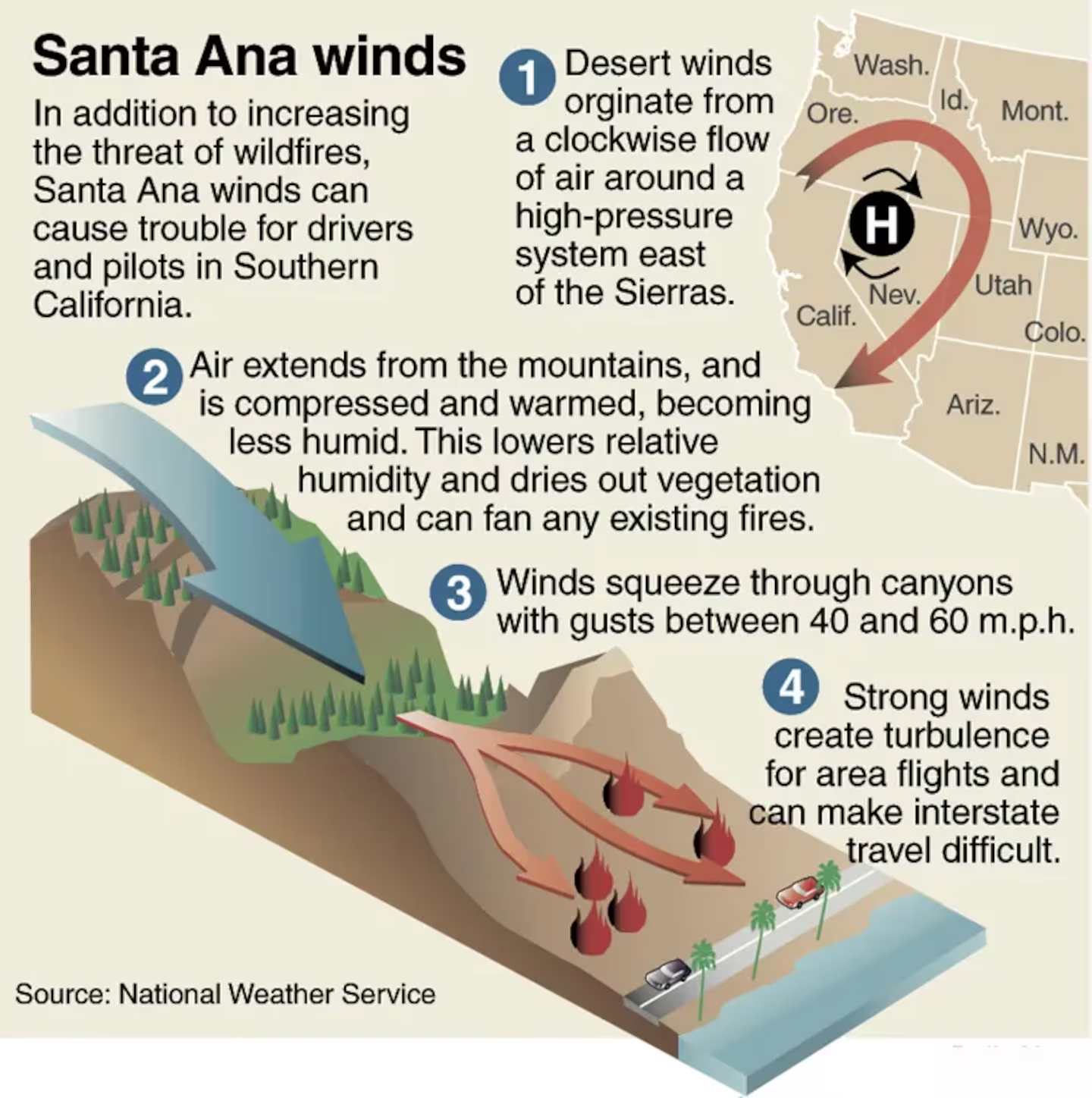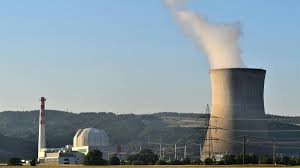- Courses
- GS Full Course 1 Year
- GS Full Course 2 Year
- GS Full Course 3 Year
- GS Full Course Till Selection
- Answer Alpha: Mains 2025 Mentorship
- MEP (Mains Enrichment Programme) Data, Facts
- Essay Target – 150+ Marks
- Online Program
- GS Recorded Course
- Polity
- Geography
- Economy
- Ancient, Medieval and Art & Culture AMAC
- Modern India, Post Independence & World History
- Environment
- Governance
- Science & Technology
- International Relations and Internal Security
- Disaster Management
- Ethics
- NCERT Current Affairs
- Indian Society and Social Issue
- NCERT- Science and Technology
- NCERT - Geography
- NCERT - Ancient History
- NCERT- World History
- NCERT Modern History
- CSAT
- 5 LAYERED ARJUNA Mentorship
- Public Administration Optional
- ABOUT US
- OUR TOPPERS
- TEST SERIES
- FREE STUDY MATERIAL
- VIDEOS
- CONTACT US
Southern California Wildfires 2025: Why Are They Happening in Winter and Why Are They So Intense?
Southern California Wildfires 2025: Why Are They Happening in Winter and Why Are They So Intense?
13-01-2025

- In January 2025, wildfires caused widespread destruction in Southern California, particularly in Los Angeles.
- Fires like the Palisades fire, Eaton fire, Sunset fire, Hurst fire, and Lidia fire are currently raging across the region, resulting in the loss of 10 lives, the evacuation of over 130,000 people, and the destruction of homes, including those of several celebrities such as Paris Hilton, Adam Brody, and Billy Crystal.
- What's particularly alarming about these fires is that they are occurring in winter, a time traditionally not associated with wildfires in California. So, why is Los Angeles burning in winter, and why are these fires so fierce?
- This event has caught attention not only for its timing but also for the factors that have made this wildfire season so deadly and destructive.
Key Factors Behind the Severity of the Wildfires:
While the exact cause of the fires remains under investigation, experts believe three main factors contributed to the intensity and rapid spread of these wildfires:
1. Wet Weather Followed by Extremely Dry Conditions
-
Wet Winters of 2022-2023:
- Southern California experienced unusually wet winters in 2022 and 2023, which led to an abundance of vegetation — trees, shrubs, and grasses grew thick and healthy.
- This abundance of greenery seemed to promise a lush landscape.
-
Dry Winter of 2024:
- However, the current winter (2024) has been exceptionally dry, which means the vegetation that grew during the wet seasons has now dried out completely.
- Dry vegetation is highly flammable and serves as perfect kindling for wildfires.
-
Rainfall Statistics:
- According to NASA, Southern California has received negligible rain since October 2024.
- Climate scientist Daniel Swain stated that this winter has seen the driest start to the water year on record.
- For example, Los Angeles International Airport (LAX) recorded just 0.03 inches (0.08 cm) of rain since October 1, which marks the start of the state's water year, making this the driest start in the National Weather Service's records since 1944.
2. The Role of Santa Ana Winds
-
What Are Santa Ana Winds?:
- The Santa Ana winds are strong, dry winds that blow across Southern California, particularly from October to January.
- These winds occur when high-pressure systems in the Great Basin desert create air circulation that pushes air westward, towards the coast.
- These winds are common during this time, but this year they have been unusually strong.
-
How Santa Ana Winds Impact Wildfires:

-
- The winds pick up speed and become extremely dry as they pass through the Sierra Nevada and Santa Ana Mountains.
- When they reach Southern California, they are hot and fast-moving.
- These winds carry flames across the region, helping wildfires spread quickly.
- The winds also dry out vegetation even further, turning forests, grasslands, and shrubs into even more flammable fuel for the fires.
-
Intensity of Winds:
- Santa Ana winds are crucial in the spread of the current fires.
- The winds, combined with dry vegetation, have caused the flames to spread quickly across vast areas, including highly populated regions like Hollywood Hills and parts of Los Angeles.
3. The Impact of Climate Change
-
Global Warming and Wildfires:
- Experts agree that climate change has been contributing to the increased frequency and intensity of wildfires globally.
- In California, rising global temperatures are leading to warmer springs and summers, while also causing early snowmelt in the mountains.
- These conditions extend the fire season, creating more opportunities for fires to ignite and spread.
-
Longer Wildfire Seasons:
- A 2021 study in Nature Scientific Reports confirmed that California's wildfire season has grown longer in recent decades.
- The study showed that the annual wildfire season has lengthened by several weeks over the past 20 years, with the peak of the fire season shifting from August to July.
- This is due to warmer temperatures and earlier snow melts, which result in drier conditions for longer periods. This makes it easier for vegetation to dry out and catch fire.
-
More Intense Fires:
- As a result of warmer temperatures and longer dry seasons, the vegetation in California faces more moisture stress, making it more vulnerable to burning.
- Fires are not only starting earlier but are also becoming more intense as the hotter, drier conditions create a perfect environment for wildfires to thrive.
-
Global Warming and Extreme Weather:
- Climate change is causing extreme weather events, and California’s wildfires are part of this global trend.
- The growing threat of wildfires due to climate change has put additional strain on firefighting efforts, as fires grow larger, more frequent, and harder to control.
Why Are These Fires So Dangerous?
The combination of dry vegetation, strong winds, and climate change has created an ideal environment for wildfires to spread quickly. The following factors make these fires particularly dangerous:
-
Rapid Spread:
- Once the fire started, the strong Santa Ana winds pushed the flames rapidly through dry vegetation, reaching populated areas like Hollywood Hills, where it damaged homes, including those of celebrities like Paris Hilton and Adam Brody.
-
Difficult to Control:
- The fires have been so intense and spread so quickly that it has been difficult for firefighters to keep up.
- Over 130,000 people have been evacuated from affected areas.
-
Impact on the Community:
- Many homes and businesses have been destroyed, including in high-profile areas like Hollywood Hills.
- The Academy Awards nominations announcement was delayed by two days due to the ongoing crisis.
-
Health and Safety:
- The large amounts of smoke from the fires have contributed to poor air quality, affecting the health of residents and firefighters in the area.
- The fires are also putting a tremendous strain on emergency services, with rescue operations being complicated by the scale of the disaster.
Pink Fire Retardant To Help Control The Fires:
- As wildfires continue to spread across Southern California in January 2025, authorities have been using planes and helicopters to drop large amounts of pink fire retardant to help control the fires.
- This method has been widely used, but it is raising concerns about its environmental impact.
- As wildfires become more intense, questions about the long-term effects of using fire retardants are growing.
What is Pink Fire Retardant?
- Composition: Pink fire retardant, especially Phos-Chek brand, is a mix of chemicals made mainly from ammonium phosphate.
- These chemicals help stop the spread of fires by coating plants and making it harder for the fire to burn by limiting the oxygen it needs.
- Why is it Pink?: The pink color is added to make the fire retardant easy to see. It helps firefighters know where the retardant has been dropped, so they can plan their next moves in controlling the fire.
How Pink Fire Retardant Works
- Fire Suppression: Pink fire retardant is sprayed ahead of the fire to cover vegetation and stop it from burning. This creates a barrier to slow down the fire, giving firefighters time to manage the situation.
- Effectiveness: The effectiveness of pink fire retardants is not fully clear. While they help slow down the fire, studies show their success depends on factors like weather, terrain, and vegetation.
- A study from the U.S. Forest Service showed that the conditions in which the retardant works best are becoming rarer due to climate change.
- Timothy Ingalsbee, a former wildland firefighter, says that fire retardants are only effective in certain conditions, and those conditions are shrinking.
- Difficulty in Measuring Success: One problem is that retardants are often used along with other firefighting methods, making it hard to tell how much they actually helped in putting out the fire.
Environmental and Health Concerns
Although pink fire retardants are useful in controlling fires, they also raise several environmental and health concerns.
-
Toxicity of Heavy Metals:
- Chromium and cadmium, two heavy metals found in fire retardants, are dangerous. These metals have been linked to cancer, and can also harm the kidneys and liver.
- A 2024 study by the University of Southern California (USC) found that 850,000 pounds of these toxic chemicals have been released into the environment since 2009. This poses a risk to both humans and wildlife.
-
Harm to Aquatic Life:
- When fire retardants wash into rivers and streams, the toxic metals in them can harm or kill fish and other water-dwelling creatures.
- These chemicals disrupt the balance of life in aquatic ecosystems, affecting not only animals but also plants and water quality.
- These metals can build up in the bodies of fish, and when animals or humans consume them, it can lead to serious health problems.
-
Soil and Long-Term Pollution:
- Fire retardants also affect the soil. After the chemicals are dropped, they can seep into the ground and remain there for a long time, harming plants and the overall environment.
- These chemicals can also cause algal blooms in water, which can make the water unsafe and harm the plants and animals that depend on it.
-
Ongoing Environmental Damage:
- Fire retardants do not break down quickly, which means they stay in the environment for years, continuing to pollute soil and water.
- A report from the Los Angeles Times highlights that fire retardants can stay in the environment and cause harm for a long time.
- Between 2009 and 2021, more than 440 million gallons of fire retardants were used across the United States. This resulted in the release of over 400 tons of heavy metals into the environment.
Scale of Fire Retardant Use
- Increasing Usage: As wildfires become more frequent and severe due to climate change, the use of fire retardants is expected to keep growing. In fact, the amount of fire retardants used in the U.S. has increased significantly in recent years.
- Massive Quantities: Over 440 million gallons of fire retardant have been used on U.S. lands from 2009 to 2021. This has led to the release of more than 400 tons of heavy metals into the environment, which is a growing concern for environmental and public health.
|
Also Read |
|
| FREE NIOS Books | |




